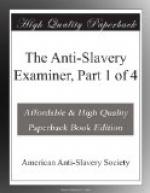Moloch, enthroned on human hecatombs, and snuffing
carnage for incense? Did He who thundered from
Sinai’s flames, “THOU SHALT NOT KILL,”
offer a bounty on murder? Whoever analyzes
the Mosaic system, will often find a moot court in
session, trying law points, settling definitions, or
laying down rules of evidence. Num. xxxv. 10-22;
Deut. xix. 4-6; Lev. xxiv. 19-22; Ex. xxi. 18, 19,
are some of the cases stated, with tests furnished
the judges by which to detect the intent, in
actions brought before them. Their ignorance
of judicial proceedings, laws of evidence, &c., made
such instructions necessary. The detail gone into,
in the verses quoted, is manifestly to enable them
to get at the motive and find out whether the
master designed to kill. 1. “If a
man smite his servant with a rod.”—The
instrument used, gives a clue to the intent.
See Num. xxxv. 16-18. A rod, not an axe,
nor a sword, nor a bludgeon, nor any other death-weapon—hence,
from the kind of instrument, no design to kill
would be inferred; for intent to kill would
hardly have taken a rod for its weapon.
But if the servant “die under his hand,”
then the unfitness of the instrument, is point blank
against him; for, striking with a rod so as
to cause death, presupposed very many blows and great
violence, and this kept up till the death-gasp, showed
an intent to kill. Hence “He shall
surely be punished.” But if he continued
a day or two, the length of time that he lived,
the kind of instrument used, and the master’s
pecuniary interest in his life, ("he is his
money,”) all made a strong case of presumptive
evidence, showing that the master did not design
to kill. Further, the word nakam, here
rendered punished, occurs thirty-five times
in the Old Testament, and in almost every place is
translated “avenge,” in a few,
“to take vengeance,” or “to
revenge,” and in this instance ALONE, “punish.”
As it stands in our translation, the pronoun preceding
it, refers to the master, whereas it should
refer to the crime, and the word rendered punished,
should have been rendered avenged. The
meaning is this: If a man smite his servant or
his maid with a rod, and he die under his hand, IT
(the death) shall surely be avenged, or literally,
by avenging it shall be avenged; that is, the
death of the servant shall be avenged
by the death of the master. So in the
next verse, “If he continue a day or two,”
his death is not to be avenged by the death
of the master, as in that case the crime was
to be adjudged manslaughter, and not murder.
In the following verse, another case of personal injury
is stated, for which the injurer is to pay a sum
of money; and yet our translators employ the same
phraseology in both places! One, an instance of




